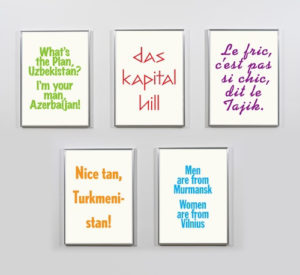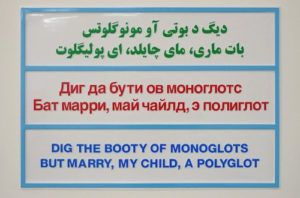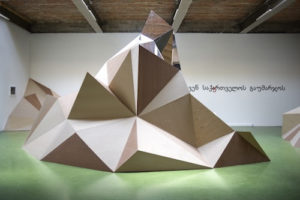Featured Artist Collective: Slavs and Tatars

Slavs and Tatars
Nations (2009)
In this gallery, which features artist collective Slavs and Tatars, we look closely at the works’ capacity to embody or enact reality by developing notions of performativity in language and text-based artwork. This edition of the ArteEast Gallery follows the Winter 2012 theme which addressed the topic of Architecture and Performativity. Slavs and Tatars’ practice is devoted to an area east of the Berlin Wall and west of the Great Wall of China known as Eurasia, redeeming an oft-forgotten, romantic sphere of influence between Slavs, Caucasians, and Central Asians.
Performativity, or the reality-producing capacity of language, was extensively discussed in John Langshaw Austin’s seminal lecture series “How to Do Things with Words” (1976) where he explains that a stated utterance of a word can enact or produce reality; Slavs and Tatars use language in their artworks to this performative effect by producing knowledge and changing the viewer’s perceptions in order to revisit, resurrect and uncover forgotten chapters of history and recontextualize them within today’s realities .
The collective’s primary practice operates in that elusive inter-cultural space, where a signifier can corresponds to different signifieds, depending on cultural context, highlighting multiple actualities of a particular story at a glance.

Slavs and Tatars
Dig the Booty (2009)
Slavs and Tatars is a faction of polemics and intimacies devoted to an area east of the former Berlin Wall and west of the Great Wall of China known as Eurasia. The collective’s work spans several media, disciplines, and a broad spectrum of cultural registers (high and low). Slavs and Tatars has published Kidnapping Mountains (Book Works, 2009), Love Me, Love Me Not: Changed Names (onestar press, 2010), and Molla Nasreddin: the magazine that would’ve, could’ve, should’ve (JRP-Ringier, 2011). Their work has been exhibited at Salt, Istanbul, Tate Modern, the 10th Sharjah, 8th Mercosul, and 3rd Thessaloniki Biennials. After devoting the past five years primarily to two cycles of work, namely, a celebration of complexity in the Caucasus (Kidnapping Mountains, Molla Nasreddin, Hymns of No Resistance) and the unlikely heritage between Poland and Iran (Friendship of Nations: Polish Shi’ite Showbiz, 79.89.09, A Monobrow Manifesto), Slavs and Tatars have begun work on their third cycle, The Faculty of Substitution, on mystical protest and the revolutionary role of the sacred and syncretic. The new cycle of work includes contributions to group exhibitions–Reverse Joy at the GfZK, Leipzig, PrayWayat the New Museum Triennial and Régions d’Être at the Asia Pacific Triennial–as well as solo engagements with Not Moscow Not Mecca at the Secession, Vienna, Khhhhhhh at Moravia Gallery, Brno, Beyonsense at MoMA, NY and Künstlerhaus Stuttgart.

Slavs and Tatars
Mountains of Wit (2009)
Such is the case in Mountains of Wit (2009), a text based wall installation spelling out Горе от Ума (Gore ot Uma), which is a famous 19th-century play about Moscow manners by Aleksander Griboyedov, a close friend of Pushkin’s and diplomat to the Czar in the Caucasus. The play is translated in English as Woe from Wit or The Misfortune of Being Intelligent. By changing the Е in the original Russian title to an Ы, the title becomes Mountains of Wit and the urban premise of the original work is hijacked by a Caucasian setting equally imaginative and historical, one which played an influential role in Griboyedov’s life and death if not his work. Similarly in To Mountain Minorities (2009), the original expression Chven Sakartvelos Gaumardjos is roughly translated as “long live Georgia or “vive Georgia.” By changing the “a” of Sakartvelos to a “u” to make Sakurtvelos, the phrase becomes “long live Kurdistan” and the unresolved geopolitical identity of one mountain people is replaced by that of another. This elegant character replacement identifies linguistic as well as contextual similarities and connections between the two resulting subjects, causing the viewer to shift their frame of reference to consider one topic from the other’s perspective and vice versa, thus bridging them together in the viewer’s intellect – ultimately revisiting history and establishing a direct relationship to it through the work.

Slavs and Tatars
Aaaaahhhhzeri!!! (2009)
While Slavs and Tatars utilize language to bridge the gaps between cultures, they ironically also employ language to highlight the limitations of inter-cultural communications. In other text-based instances of their work, transliterating is used to highlight (and poke fun at) the limitations of translation between languages and cultures. This is evident in Dig the Booty (2009) for example – a transliteration of an aphorism across Latin, Cyrillic and Farsi, in homage to the vicissitudes in the Azeri alphabet. Another tribute to the Azeri alphabet is AaaaaaahhhhZERI!!! (2009). The alphabet, which changed three times in the 20th century – first from Arabic to Latin in 1928, then to Cyrillic in 1939, and finally back to Latin in 1991 – caused immense damage to the cultural heritage of the republic, not to mention making generations of ‘Azeris’ immigrants within their own country – all divulged by a single phrase.
Investigating the theme of immigration and cross-cultural influences further is Slavs and Tatar’s Friendship of Nations: Polish Shi’ite Showbiz (2011) series. Polish and Farsi slogans adorn handmade banners from the series, which looks at the unlikely shared heritage between Poland and Iran and in particular, the revolutionary potential of crafts and folklore behind the ideological impulses of two key modern moments, the Islamic Revolution of 1979 and Poland’s Solidarność in the 1980s. One banner carries the words “Long Live Long Live! Death to Death to!” which affirms the celebratory gesture and condemns the revenge and rhetorical justice which often undermine true popular revolutions and uprisings. The slogans evoke revolutionary sentiments in the viewers, causing them to visualize an alternate reality to their own – in which lies the essence of the work’s performativity elements.

Slavs and Tatars
Long live long live (2011)
Moreover, the use of language in the collective’s artworks ensures an accessible mode of reception to their work, non-discriminating between those with prior art historical, sociological, or anthropological knowledge and those who don’t, thus opening a wider window to the intriguing landscape of Eurasian history. So, by activating the performative potential of language, Slavs and Tatars’ text-based artworks utilize its significatory ability to validate histories and transform them from stories to realities cultivated in the viewer’s perception.
Biography:
Dina Ibrahim is a curator and writer currently based in Dubai. She is the curator of ArteEast virtual gallery and previously held various positions in a number of international art museums including the Guggenheim in New York and Queensland Art Gallery in Australia. She also currently holds the title of exhibitions coordinator at The Third Line in Dubai orchestrating all aspect of exhibition development in the space. She contributes to numerous art publications such as e-flux ArtAgenda, ArtAsiaPacific, Whitewall, ArtLink, and Frieze. She obtained an Art History degree from the University of Queensland in Australia where she graduated with honors and is currently pursuing her thesis in cross-cultural curating with a focus on contemporary Middle Eastern Art.